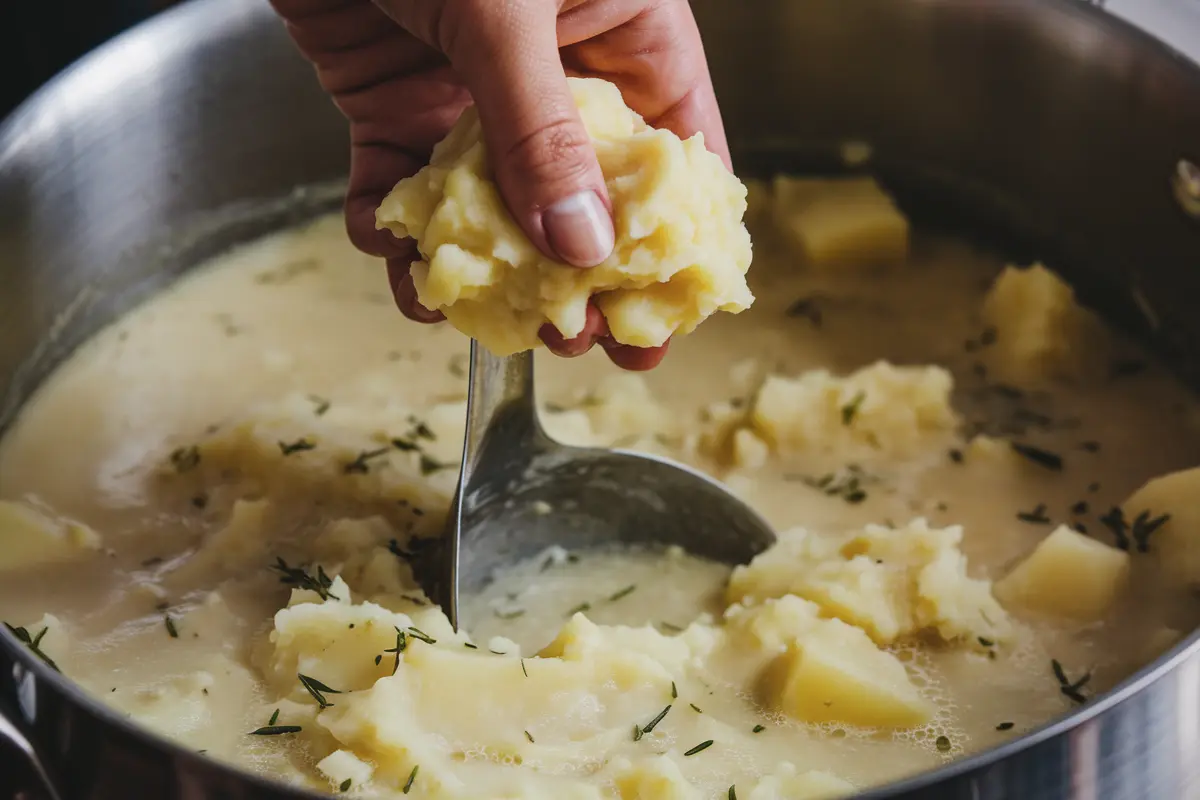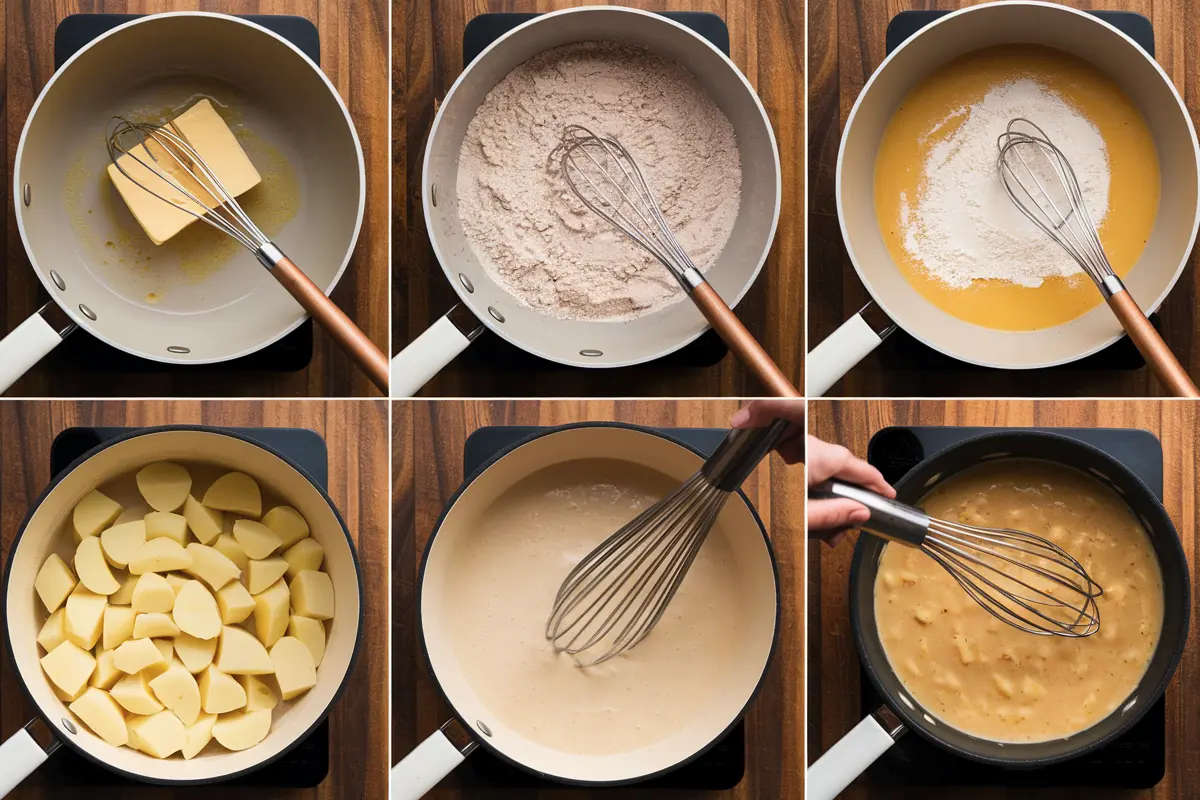Potato soup is a beloved comfort food, perfect for chilly days when you need something warm and filling. However, one of the most common challenges faced by home cooks is achieving the ideal consistency. A thin, watery soup can be disappointing, leaving you craving that rich, creamy texture that makes potato soup so satisfying. Fortunately, there are several methods to thicken your potato soup effectively, whether you’re aiming for a hearty, chunky finish or a velvety, smooth texture. This guide will walk you through the best techniques, from traditional methods to innovative alternatives, ensuring your soup turns out perfect every time.
Understanding Why Your Potato Soup Might Be Thin
Before diving into the thickening techniques, it’s essential to understand why your potato soup might turn out thinner than expected. Recognizing the causes can help you avoid these issues in the future, ensuring a perfect result every time.
Common Reasons for Thin Potato Soup
- Incorrect Liquid-to-Solid Ratio: One of the most common mistakes is using too much liquid relative to the amount of potatoes. The key to a thick, creamy soup is maintaining a proper balance between the liquid (broth, water, or milk) and the solids (potatoes, vegetables).
- Insufficient Cooking Time: Potatoes need time to cook thoroughly and release their natural starches, which act as a natural thickening agent. If your soup is not cooked long enough, the starches won’t have time to do their job, resulting in a thinner consistency.
- Improper Use of Thickening Agents: Adding thickening agents incorrectly can also lead to a thin soup. For example, if flour is not cooked properly or cornstarch is not mixed thoroughly, they may not thicken the soup as expected.
Understanding these factors can help you avoid common pitfalls and set the stage for successfully thickening your soup.
Traditional Thickening Agents for Potato Soup
Now that we’ve covered the common reasons for thin soup, let’s explore the traditional methods for thickening potato soup. These techniques have been used for generations and are reliable ways to achieve a thick, hearty soup.
Potatoes as a Thickener
Since potatoes are the main ingredient in potato soup, it makes sense to use them as a thickening agent. This method is simple and effective:
- Mashing or Blending Potatoes: After the potatoes have cooked in the soup, remove a portion of them, mash or blend them, and then stir them back into the soup. This technique not only thickens the soup but also enhances its texture, making it creamier.
- Using Potato Flakes: Instant potato flakes can also be used to thicken the soup. Simply stir in the flakes a little at a time until the soup reaches your desired consistency. This method is quick and easy, perfect for those who need to thicken their soup in a pinch.

Roux: The Classic Thickening Agent
A roux is a classic thickening agent made from equal parts fat (such as butter) and flour. It’s commonly used in French cuisine and is a staple in many soup recipes. Here’s how to use a roux to thicken your potato soup:
- Making the Roux: Melt butter in a saucepan over medium heat, then whisk in an equal amount of flour. Stir constantly until the mixture forms a smooth paste and cook for a few minutes to eliminate the raw flour taste.
- Incorporating the Roux: Gradually whisk the roux into your simmering potato soup. As it heats, the roux will thicken the soup, adding a rich, creamy texture. This method works well for soups that need a substantial thickening boost.
Cornstarch Slurry: A Gluten-Free Option
For those looking for a gluten-free thickening option, a cornstarch slurry is an excellent choice.
- Creating the Slurry: In a small bowl, mix 1 tablespoon of cornstarch with 2 tablespoons of cold water. Stir until the cornstarch is fully dissolved and forms a smooth mixture.
- Thickening the Soup: Gradually add the slurry to the simmering soup, stirring constantly to ensure it is evenly distributed. As the soup continues to simmer, it will thicken, giving you a smooth, velvety texture.
Non-Traditional Thickening Methods
While traditional methods are reliable, there are many other creative ways to thicken potato soup. These methods can add unique flavors and textures to your soup, allowing you to experiment and find the perfect consistency for your tastes.
Dairy Products: Cream, Milk, and Yogurt
Dairy products such as heavy cream, milk, and yogurt not only thicken potato soup but also enhance its flavor and richness:
- Heavy Cream: Adding heavy cream to your soup will give it a luxurious, velvety texture. Because cream is high in fat, it’s particularly effective at creating a thick, rich consistency.
- Milk: Whole milk can also be used to thicken soup, though it won’t be as thick as cream. For best results, simmer the soup after adding milk to allow it to reduce and thicken.
- Yogurt: For a tangy twist, try adding yogurt to your soup. Greek yogurt is particularly effective, as its thick texture will give the soup a rich, creamy consistency. Just be sure to add yogurt slowly and at a low temperature to prevent curdling.
Cheese: Adding Flavor and Thickness
Cheese is another excellent way to thicken potato soup while adding a delicious flavor:
- Cheddar Cheese: Stirring shredded cheddar cheese into your soup can thicken it and give it a savory, cheesy flavor. Cheddar is a good choice because it melts well and blends smoothly into the soup.
- Other Cheeses: You can also experiment with other types of cheese, such as Parmesan or Gouda, depending on your flavor preferences. Each type of cheese will add its unique taste and texture to the soup.
Bread and Grains: An Unexpected Thickener
If you’re looking for a way to thicken your soup without adding too many additional ingredients, consider using bread or grains:
- Stale Bread: Soak pieces of stale bread in the soup until they break down, then stir them in to thicken the soup. This method is particularly useful if you have leftover bread that would otherwise go to waste.
- Rice or Lentils: Adding a small amount of rice or lentils to your soup can help thicken it as they cook and release their starches. This method also adds a hearty texture to the soup, making it more filling.
Reduction: A Natural Way to Thicken
Reduction is a technique that involves simmering the soup for an extended period to evaporate excess liquid, naturally thickening the soup:
- Simmering the Soup: After all the ingredients have been added, allow the soup to simmer uncovered. As the liquid evaporates, the soup will thicken, and the flavors will concentrate.
- Controlling the Thickness: Keep a close eye on the soup as it simmers, stirring occasionally to prevent it from sticking to the bottom of the pot. Once the soup reaches your desired thickness, remove it from the heat.
For the ultimate thick, creamy potato soup, consider combining multiple thickening methods. This approach allows you to fine-tune the texture and flavor of your soup to achieve the perfect consistency.
Mixing and Matching Techniques
Here are a few combinations to try:
- Roux and Mashed Potatoes: Start with a roux to thicken the base, then stir in mashed potatoes for added body and creaminess. This combination is particularly effective for soups that need a substantial thickening boost.
- Cornstarch Slurry and Dairy Products: If you’re using milk or cream to thicken your soup, add a cornstarch slurry towards the end of cooking to give the soup a final thickening boost. This combination is ideal for creating a rich, velvety texture.
Balancing Flavors and Textures
When combining thickening methods, it’s important to balance the flavors and textures to ensure the soup remains delicious and satisfying:
- Taste as You Go: As you add thickening agents, taste the soup frequently to ensure the flavors remain balanced. Adjust the seasoning as needed, adding salt, pepper, or herbs to enhance the soup’s flavor.
- Control the Consistency: If the soup becomes too thick, thin it out by adding more broth or milk. Conversely, if it’s not thick enough, add more of your chosen thickening agent. This flexibility allows you to customize the soup’s texture to your liking.
Thickening Potato Soup for Special Diets
Whether you’re following a gluten-free, keto, or dairy-free diet, there are plenty of options for thickening potato soup that meet your dietary needs.
Gluten-Free Thickening Agents
For those avoiding gluten, several thickening agents work well in potato soup:
- Potato Starch: Potato starch is a gluten-free thickener that’s particularly effective in soups. It doesn’t alter the flavor of the soup and provides a smooth, thick texture. To use, mix potato starch with a small amount of water to create astir, then add it to the soup. As it heats, the potato starch will thicken the soup quickly, so add it gradually to avoid over-thickening.
- Cornstarch: Cornstarch is another gluten-free thickening option that works similarly to potato starch. It creates a smooth texture and doesn’t alter the soup’s flavor, making it a versatile choice.
- Arrowroot: Arrowroot is a lesser-known thickening agent that’s also gluten-free. It’s ideal for those with dietary restrictions and provides a smooth, glossy finish to soups.
Keto-Friendly Thickening Options
If you’re following a keto diet, focus on thickening agents that are low in carbs:
- Butter and Cheese: Adding extra butter and cheese to your soup can thicken it without adding carbs. These ingredients also enhance the flavor and richness of the soup, making it more satisfying for those on a keto diet.
- Heavy Cream: Heavy cream is high in fat and low in carbs, making it an excellent choice for thickening keto-friendly soups. It adds a rich, creamy texture without the need for flour or other high-carb thickeners.
Dairy-Free Alternatives
For those avoiding dairy, there are still plenty of ways to thicken potato soup:
- Coconut Milk: Coconut milk is a dairy-free alternative that adds creaminess and a slight sweetness to soups. It’s a great option for those who want to thicken their soup without using dairy products.
- Plant-Based Creamers: Plant-based creamers, such as those made from almonds, cashews, or soy, can also be used to thicken potato soup. These creamers are typically thicker than plant-based milks, making them more effective at creating a creamy texture.
Common Mistakes and How to Fix Them
Even with the best intentions, mistakes can happen when thickening potato soup. Here’s how to fix some common issues:
Over-Thickening
If your soup becomes too thick, it can be difficult to enjoy. Fortunately, this issue is easy to fix:
- Thin It Out: Gradually add more broth, milk, or water to the soup, stirring constantly to ensure it is evenly distributed. Be careful not to add too much liquid at once, as this can dilute the soup’s flavor.
- Balance the Seasoning: After thinning the soup, taste it to ensure the flavors are still balanced. You may need to add more salt, pepper, or other seasonings to bring the soup back to its original flavor profile.
Lumps in the Soup
Lumps can form if thickening agents aren’t properly mixed before being added to the soup. Here’s how to avoid and fix lumps:
- Prevent Lumps: To prevent lumps, always mix thickening agents like flour or cornstarch with a small amount of cold water before adding them to the soup. This step ensures they are fully dissolved and won’t clump when heated.
- Remove Lumps: If lumps do form, you can try whisking the soup vigorously to break them up. If that doesn’t work, use an immersion blender to blend the soup until it is smooth.
Maintaining Flavor Balance
When thickening soup, it’s important to maintain the balance of flavors. Here’s how to do it:
- Taste as You Go: As you add thickening agents, taste the soup frequently to ensure the flavors remain balanced. If the soup becomes too bland, add more seasoning to enhance the flavor.
- Control the Thickness: If the soup is too thin, add more thickening agent gradually. If it’s too thick, thin it out with a small amount of liquid. This flexibility allows you to achieve the perfect consistency without sacrificing flavor.
Serving Suggestions and Pairings
A thick, creamy potato soup is a meal in itself, but it can be made even more enjoyable with the right accompaniments. Here are some serving suggestions to elevate your soup experience:
Crusty Bread
There’s nothing like a warm, crusty bread to dip into a bowl of thick potato soup. Whether you choose a classic French baguette or a slice of homemade sourdough, bread is the perfect complement to the rich, creamy texture of the soup.
Fresh Salads
A light, fresh salad provides a nice contrast to the richness of potato soup. Consider a simple green salad with a tangy vinaigrette, or a more robust salad with roasted vegetables and a creamy dressing. The freshness and crunch of the salad will balance the soup’s creaminess.
Garnishes and Toppings
Adding garnishes and toppings to your potato soup can enhance its flavor and texture. Here are some popular options:
- Bacon Bits: Crispy bacon bits add a smoky, savory flavor that complements the creaminess of the soup.
- Shredded Cheese: A sprinkle of cheddar or Parmesan cheese adds richness and depth to the soup.
- Sour Cream: A dollop of sour cream adds tanginess and creaminess, making each spoonful more indulgent.
- Chives or Green Onions: Fresh herbs like chives or green onions add a pop of color and a mild, oniony flavor that brightens up the soup.
Frequently Asked Questions (FAQs)
How do I fix potato soup that’s too thick?
If your soup is too thick, gradually add more liquid, such as broth or milk, while stirring constantly. This will help thin the soup to your desired consistency without diluting the flavor too much.
Can I thicken potato soup without flour?
Yes, you can thicken potato soup without flour by using alternatives like cornstarch, potato starch, or arrowroot. These options are gluten-free and can be used to create a smooth, thick texture without altering the soup’s flavor.
Is it possible to thicken potato soup without altering the flavor?
Yes, it’s possible to thicken potato soup without significantly altering the flavor by using neutral thickeners like potatoes, cornstarch, or arrowroot. These ingredients thicken the soup without adding any strong flavors.
What is the best way to thicken potato soup on a gluten-free diet?
For a gluten-free option, use potato starch, cornstarch, or arrowroot as thickening agents. These options are effective at thickening soup while keeping it gluten-free.
Can I use instant potatoes to thicken my soup?
Yes, instant potato flakes can be used to thicken soup quickly and easily. Simply stir in the flakes a little at a time until the soup reaches your desired thickness.
Conclusion
Achieving the perfect consistency in potato soup is a culinary skill that can elevate this comfort food to new heights. Whether you prefer a thick, hearty soup or a smooth, velvety texture, the methods outlined here will help you create a dish that satisfies every time. By combining different techniques like using mashed potatoes, incorporating a roux, or experimenting with dairy products, you can customize the thickness of your soup to suit your preferences.
For more inspiration and additional potato soup recipes, check out EllieRecipes’ classic potato soup recipe, which offers a step-by-step guide to making a delicious bowl of soup. You can also explore what potato soup typically contains to understand the core ingredients and variations you can experiment with.
For further expert advice on thickening soups, consider visiting Bon Appétit’s guide to soup consistency. These resources offer valuable insights and additional techniques that can help you perfect not just potato soup, but a variety of other soups as well.
With these tools and insights, your potato soup will not only be thicker but also more flavorful and satisfying, making it a staple in your kitchen all year round.


